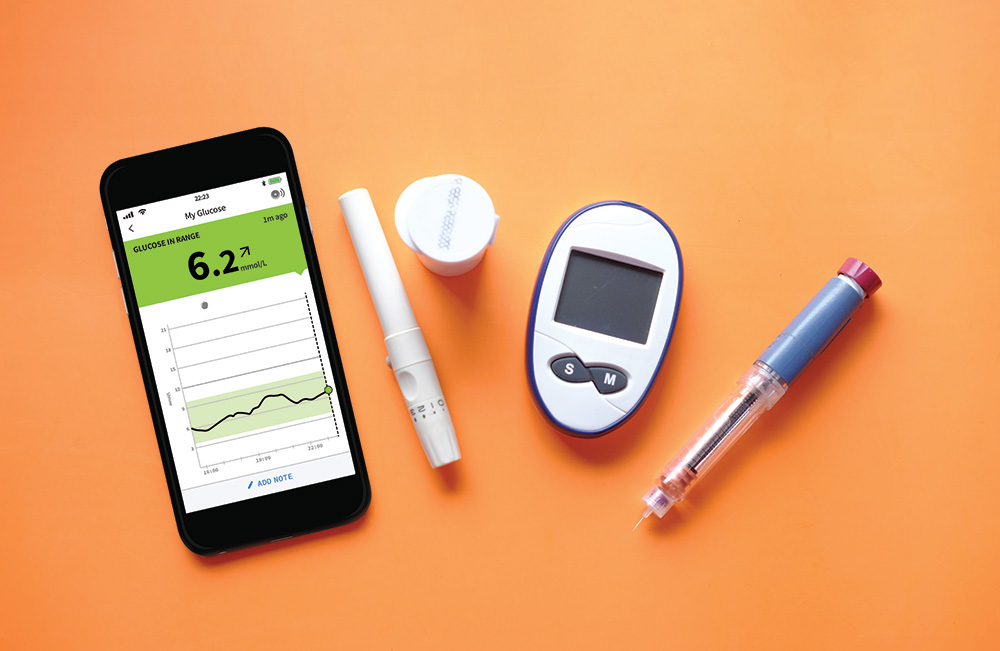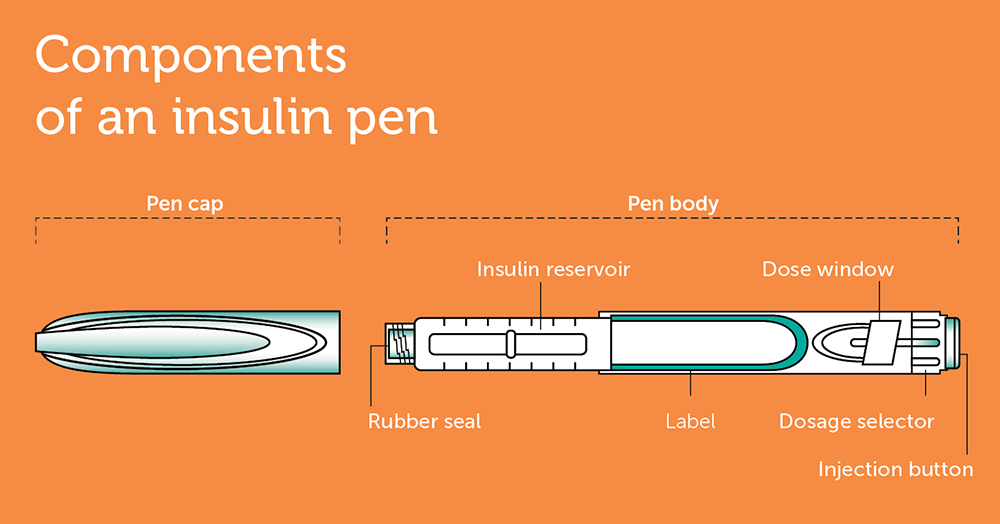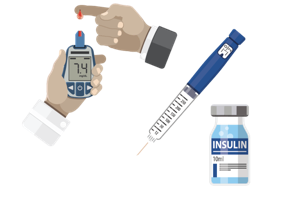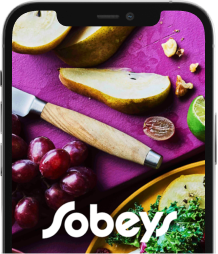
- Your diabetes care team can help you to figure out the best type of insulin for you, and show you how to take it.
- Remember that needing to take insulin is not a sign of failure. It is normal to use insulin at some point, since your body changes over time.
- Avoid doing injections in the same spot, as scar tissue can build up under the skin and make it difficult for the insulin to be absorbed. Choose a spot two to three finger widths away from your last injection site.
Did your doctor recently say that you need to start insulin therapy? You may feel surprised, unsure or worried to hear that you need to take insulin, and wonder if you have been managing this condition well. Keep in mind that diabetes and your body change over time. What worked well once may require adjustment. Insulin is just one more tool to help you manage and control your diabetes. While insulin is an important part of diabetes care, there is much to understand about how it helps to manage your diabetes.
Along with healthy eating and exercise, taking insulin helps you to avoid hyperglycemia (high blood glucose). Continuously high blood glucose can lead to long-term health complications that affect the heart, kidneys, eyes, and other organs. With some education and the help of your diabetes team, starting insulin can be simpler than expected. Remember, taking insulin does not mean you have failed, but is part of natural changes in life.
1 – What is insulin?
Insulin is a hormone made by the pancreas. It acts to control glucose (sugar) levels in the blood. Without insulin, glucose can start to build up in the blood stream. In diabetes, the pancreas is not able to make enough insulin, or the body has trouble using the insulin that is made. Diabetes is progressive condition, which means it could get worse over time. If the pancreas isn’t making enough insulin, insulin therapy provides your body with what it needs.
There are many different types of insulin.
- Basal (long-acting) insulins are injected once or twice daily to provide a constant level of insulin throughout the day. This helps to keep blood glucose at a consistent level when you are not eating and through the night. Basal insulin alone may not be able to manage the food eaten for meals and snacks, or glucose spikes after meals.
- Prandial (rapid-acting or ‘mealtime’) insulins are taken before each meal. They work quickly to manage the food you have eaten and bring down high glucose levels following meals.
Some people need to use both a basal and a prandial insulin each day. Others only need to use basal insulin. Your diabetes healthcare team can help you to find an insulin treatment that works with your lifestyle.
2 – How do I use insulin?
While there are different methods of using insulin, many people find that an insulin pen is the easiest to use and more convenient than using a vial and a syringe. Some insulin pens come prefilled. With others, a cartridge containing insulin is put into the pen. The cartridge is removed when empty, and a new cartridge inserted.
Again, your diabetes team can help you figure out which will work best for you.
When it comes to using your insulin pen, you will find simple instructions in the book that comes with the pen. Diabetes Canada also has helpful videos. If you still feel unsure, a diabetes health care professional can show you how to use the insulin pen. It is easy to learn, and somewhat like riding a bike. Once you have done it a few times, you will know exactly what to do.
Rapid-acting insulins work quickly to manage the food you have eaten and bring down high glucose levels following meals.

3 – What needle size should I use?
Pens come in various needle sizes. The Forum for Injection Technique (FIT) guidelines were developed to establish and promote the best injection techniques for all those involved in diabetes care. These guidelines recommend using the smallest needle, which is four millimetres. All you need to do is get right below the skin. Skin is normally less than one to two millimetres thick. While an injection can be a little uncomfortable, proper technique and practice can make it less painful.
4 – Where should I inject the insulin?

- The abdomen is the easiest to reach. This is the area where insulin absorbs quickly and consistently. Stay five centimetres (two inches) away from your belly button.
- Try not to inject in the same spot. Make sure you are two to three finger widths away from where you last injected.
- The buttock and thigh have a slower rate of insulin absorption than the abdomen and arm.
- The outer arm has the next fastest absorption rate after the abdomen. This area is hard to reach, so it is often not recommended for injecting yourself.
5 – What problems should I watch for when I use insulin?
The most common side effect of using insulin is the chance of low blood glucose (hypoglycemia). This is a blood glucose level of less than 4 mmol/L. Low blood glucose can happen due to:
- too much exercise or being too active.
- going a long time without food.
- taking extra diabetes medication or insulin.
If your blood glucose is low, you may feel:
- dizzy
- shaky
- sweaty
- hungry
- weak or tired
- confused
- irritable
Low blood glucose requires fast treatment
Check your blood glucose level if you experience any of the above symptoms. It is very important to treat low blood glucose right away. Without treatment, you could pass out. If you do not have your meter but feel like your blood glucose could be low, treat it anyway. Eat or drink 15 grams of a fast-acting carbohydrate, such as one of the following:
- 15 grams of glucose in the form of glucose tablets (preferred choice)
- 1 tablespoon (15 ml) or three packets of table sugar or five sugar cubes dissolved in water
- 150 mL (2/3 cup) of juice or regular soft drink
- 6 Lifesavers (1 = 2.5 grams of carbohydrate)
- 15 mL (1 tablespoon) of honey (do not use honey for children less than one year of age.)
Wait 15 minutes, then check your blood glucose again.
If it is still low, treat again with the carbohydrate and test your blood glucose in 15 minutes. Repeat these steps until your blood glucose is above 4 mmol/L.
If your blood glucose is above 4 mmol/L and your next meal is within an hour, no further action is needed. If your next meal is over one hour away or you will be physically active, eat a snack with 15 grams of carbohydrate and a protein source. Examples are half of a sandwich or some cheese and crackers.
Wait 40 minutes after treating low blood glucose to drive.
6 – How do I store my insulin?
Keep unopened insulin in the fridge. A few hours before you need to use a new insulin pen or cartridge, take it out of the fridge. Once in use, it can stay at room temperature for up to 28 days. Some insulins can stay out of the fridge longer, so ask your pharmacist about your specific type of insulin.
Insulin is affected by extreme temperatures. Keep your insulin away from direct sunlight and avoid temperatures higher than 30ºC. Do not leave it in your car in the summer, and do not put it in the freezer. Discard insulin that has been frozen or exposed to heat greater than 30ºC.
It is normal to feel a bit nervous when starting to use insulin. Remember, millions of people take insulin as part of living with diabetes. To learn more, visit your nearest diabetes health centre or the Diabetes Canada website.
Resources
- Diabetes Canada website www.diabetes.ca
- Diabetes Canada YouTube Channel tinyurl.com/Diabetes-CA-YouTube
- Diabetes Canada | How to Inject Insulin – Step by Step Guide tinyurl.com/Insulin-Step-By-Step
- Getting Started with Insulin tinyurl.com/Start-Insulin
- Blood Glucose Highs and Lows tinyurl.com/Glucose-High-Low
WRITTEN BY: Melodee Dayrit, RN, BScN, CDE, a certified diabetes nurse educator with St. Paul’s Diabetes Health Centre in Vancouver, British Columbia.



